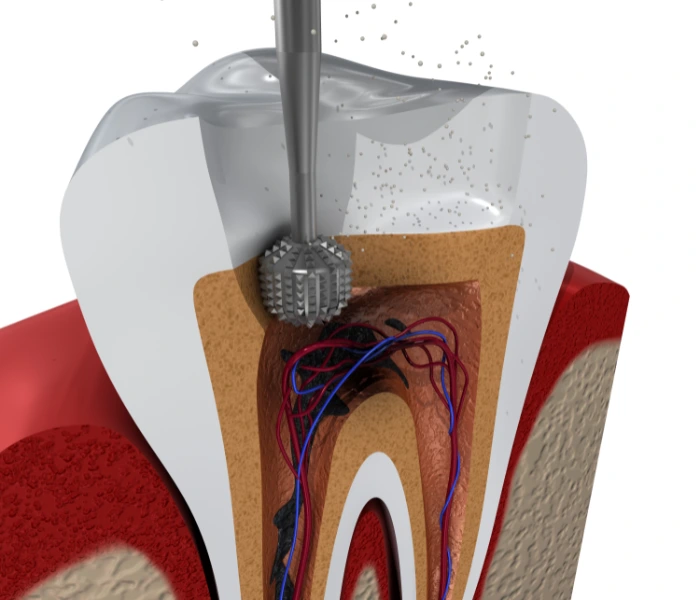At Higher Ground Dentistry in Upland, Dr. Sikka and our team want to help you understand root canal treatment. Hearing those words often makes people nervous. However, once you know how the procedure works, you’ll see it’s not as scary as it sounds. In fact, root canal treatment is one of the best ways to save a natural tooth when the inside becomes infected or badly damaged.
Why Root Canal Treatment Matters
Think of your tooth as a little house. Inside, there’s soft tissue called pulp, and it’s packed with nerves and blood vessels that keep everything running. But when deep decay, an injury, or too many dental procedures reach that pulp, trouble starts fast.
The infection doesn’t just sit there—it spreads. Without quick care, the tooth can die and might even need to be pulled. That’s where root canal treatment steps in. It stops the infection, eases pain, and lets you hang on to your natural tooth for years instead of losing it. You can also learn more about root canal therapy from the American Dental Association.

Signs You Might Need Root Canal
Not every toothache means you need a root canal, but here are some warning signs you shouldn’t brush off:
- Sharp or throbbing pain when chewing
- Sensitivity to hot or cold that lingers
- Tooth darkening or odd discoloration
- Swollen, tender gums around one tooth
- Pimple-like bumps that come back on your gums
- Chips or cracks that expose the inside of a tooth
- Pain that seems to “spread” to other teeth
- Nighttime aches that interrupt sleep
- One-sided facial swelling
Here’s the deal: if you wait too long, the infection can move into your jawbone, nearby tissues, or even your bloodstream. While this is rare, it can get serious. Acting early makes root canal treatment easier and recovery smoother. That’s why regular dental checkups are so important for catching problems before they get worse. For additional trusted information, visit the CDC oral health resources.
What Happens During Root Canal
At Higher Ground Dentistry, comfort comes first. Thanks to modern tools and techniques, the root canal procedure is simpler than most people expect:
1. Exam and Imaging – First, Dr. Sikka takes digital X-rays to get a clear picture and plan the right approach for your root canal treatment.
2. Numbing the Tooth – Next, local anesthesia keeps you pain-free. Feeling nervous? Sedation options are available.
3. Accessing the Pulp – Then, a tiny opening gives access to the infected tissue while keeping everything clean and sterile.
4. Cleaning and Shaping – The root canals are carefully cleaned, shaped, and cleared of bacteria.
5. Sealing the Tooth – The space is disinfected and filled with a safe material, then protected with a temporary filling.
6. Final Restoration – Finally, a crown or permanent filling is placed later to restore strength and appearance.
You can also read a trusted Mayo Clinic overview of root canal treatment to see how it compares to our approach.
What Root Canal Recovery Looks Like
Most patients recover faster than they expect after root canal treatment. Your mouth may stay numb for a few hours, but many people return to work or daily activities the same day.
For the first day or two, it’s best to stick to soft foods and avoid chewing on the treated side. You may feel mild soreness or sensitivity for a couple of days. Over-the-counter medicine usually helps manage any discomfort.
If pain is severe, swelling increases, or a filling feels loose, call our office right away. Most people heal within a week and feel completely normal once the final crown is placed.
Tips for a Smooth Root Canal Healing Process
To heal comfortably and protect your tooth after root canal treatment:
- Rinse gently with warm salt water to reduce irritation
- Eat soft, nourishing foods like soup, yogurt, or smoothies
- Avoid tobacco, which slows healing and raises infection risk
- Brush and floss gently, especially around the treated tooth
- Stay away from sticky or hard foods until your crown is in place
Schedule Your Root Canal Consultation in Upland
Tooth pain never gets better on its own. If you think you may need root canal treatment, don’t wait. Call Higher Ground Dentistry today. Dr. Sikka will examine your tooth, explain your options, and help you feel at ease every step of the way.
We offer flexible scheduling—including weekends—and our bilingual staff (English and Spanish) makes communication simple. You’ll find us at 121 W Foothill Blvd, Suite E, Upland, CA 91786, proudly serving the Inland Empire with advanced dental care.


